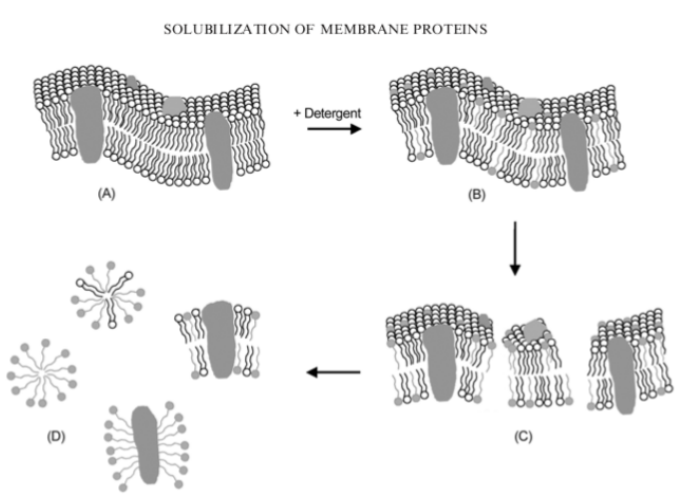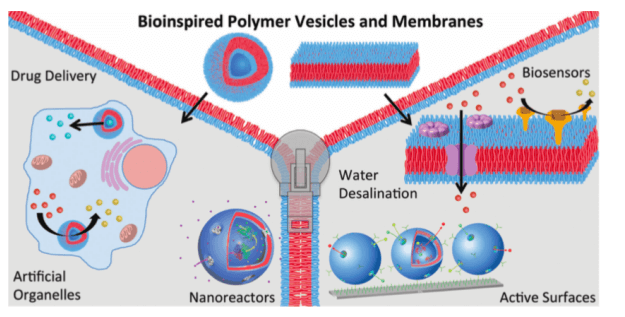Synthesized Polymeric Bilayers for Membrane Protein Solubilization and Incorporation
Biological membranes play essential roles in living organisms by providing stable and functional compartments, preserving cell architecture, whilst supporting signaling and selective transport that are mediated by a variety of proteins embedded in the membrane. Synthesized polymeric membranes can be used to understand the functions of many materials in biomolecules and medicine. It can be used in large range of applications such as biosensor, drug delivery and cancer treatment.
Biological membranes are complex combinations of many kinds of lipids and proteins that represent important sites for several cellular signaling functions. They are useful to dissociate the membrane into its components for the understanding of functions of biological membranes. Therefore purification of membrane proteins can be very challenging in contemporary molecular biology.
Solubilization is an essential procedure to remove the target proteins carefully from the native membrane and disperse the target proteins separately in solution by using amphiphilic detergents. During solubilization, the lipids and proteins are combined together in the native membranes; then dissociated in a buffered detergent solution. Small protein and lipid clusters are formed because of the controlled dissociation of membranes. Small protein and lipid clusters are remained in the aqueous solution. It is important to understand the structure-function relationship of a target protein by solubilization and purification of a membrane protein in a functionally active form.
Many membrane proteins are considered to possess tremendous therapeutic potential, but there is still a challenge of solubilization of a membrane protein with retention of activity, because many detergents will denature the membrane proteins. Different stages of solubilization of membrane protein is shown in Figure 1. When low concentrations of detergents are added to biological membranes (Figure 1A), the detergent monomers merely bind to the membrane with minimal perturbation of the membrane followed by penetration into the membrane (Figure 1B). As the concentration of detergent increases, the membrane bilayer is disrupted (Figure 1C). At still higher detergent concentrations, heterogeneous complexes of detergent, lipid and protein begin to form which result in mixed micelles of lipid and detergent and that of protein and detergent (Figure 1D).
 Figure 1. Different detergent solubilization stages of membrane protein.
Figure 1. Different detergent solubilization stages of membrane protein.
Advantages and applications of synthesized polymeric bilayers
Synthesized structures can be used to understand the functions of many materials in different aspects such as materials science, chemistry, electronics and medicine. It is also involved in the combination of biomolecules, such as enzymes, proteins, or nucleic acid with synthetic materials. Polymeric structures provide a large variety of topologies that permit the insertion/encapsulation/attachment of biomolecules. In addition, the properties of the membranes can be adjusted by chemical modification to support the match with biological molecules, while preserving the characteristics of synthetic materials, such as stability and mechanical robustness.
Synthesized polymeric membranes have a large variety of applications ranging from drug delivery systems up to artificial organelles, or active surfaces (Figure 2). For example, biological polymeric membranes can be used as monolayers at air-water interface for investigating interactions with biomolecules in various conditions; Polymeric membranes can also be used for cancer therapy, Proposed applications of responsive polymersomes in cancer therapy have mainly focused on systemic delivery of smart loaded polymersomes, which can passively target tumour regions by the enhanced permeation and reten-tion effect (EPR) known for solid tumours or local intra- tumoural injection to circumvent the requirements needed for long blood circulation time; Polymer membrane based biosensors have been applied both for detection in solutions and at surfaces, in biochemical arrays, and in the form of immobilized nanoreactors on prefabricated active surfaces.
 Figure 2. Polymer membranes highlighting some potential applications of such assemblies.
Figure 2. Polymer membranes highlighting some potential applications of such assemblies.
References:
- Thomas, C. T., and McNamee, M. G. Purification of membrane proteins. Methods Enzymol. 1990. 182, 499 – 520.
- Helenius, A., and Simons, K. Biophys. Acta.,1975. 415, 29 – 79.
- Garavito, R. M., and Ferguson-Miller, S. J. Biol. Chem. 2001. 276, 32403 – 32406.
- R. J. Peters, M. Marguet, S. Marais, M. W. Fraaije, J. C. van Hest and S. Lecommandoux, Angew. Chem., Int. Ed., 2014, 53, 146–150.
- P. Baumann, P. Tanner, O. Onaca and C. G. Palivan, Polymers, 2011, 3, 173–192.
- P. Baumann, V. Balasubramanian, O. Onaca-Fischer, A. Sienkiewicz and C. G. Palivan, Nanoscale, 2013, 5, 217–224.
- X. Y. Zhang, P. Tanner, A. Graff, C. G. Palivan and W. Meier, J. Polym. Sci., Part A: Polym. Chem., 2012, 50,2293–2318.
- J. Lin, S. Wang, P. Huang, Z. Wang, S. Chen, G. Niu, W. Li, J. He, D. Cui, G. Lu, X. Chen and Z. Nie, ACS Nano, 2013, 7, 5320–5329.
